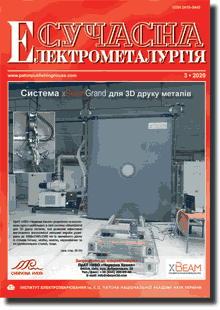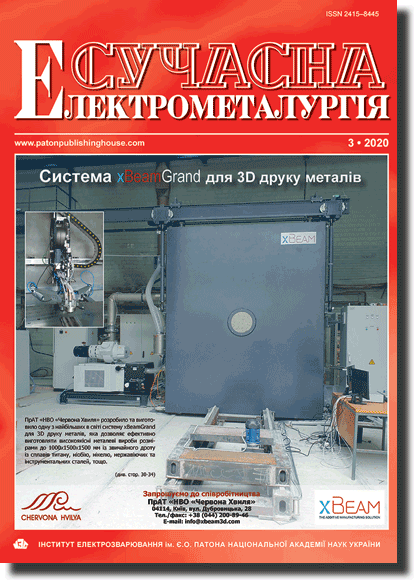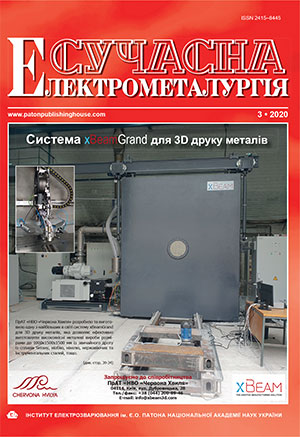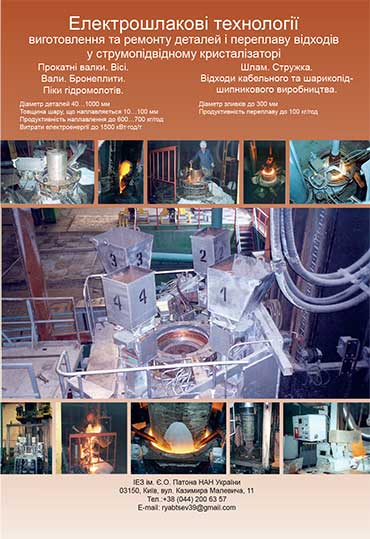| 2020 №03 (04) |
DOI of Article 10.37434/sem2020.03.05 |
2020 №03 (06) |

"Suchasna Elektrometallurgiya" (Electrometallurgy Today), 2020, #3, 35-42 pages
Physical and technical prerequisites for development of metallurgical plasmatrons
V.V. Stepanenko, I.V. Sheiko, D.M. Zhirov, T.I. Dubova, V.V. Barabash
E.O. Paton Electric Welding Institute of the NAS of Ukraine. 11 Kazymyr Malevych Str., 03150, Kyiv, Ukraine. E-mail: office@paton.kiev.ua
Abstract
The paper considers the physical and technological aspects of creating arc plasmatrons designed to operate in metallurgical smelting units and furnaces. Based on analysis of literature sources, a classification of metallurgical plasmatrons by the principle of plasma gas heating to plasma state is proposed. According to this classification, all the metallurgical plasmatrons are divided into four groups: arc, induction, electron and fuel. It is shown how in each group gas is heated to a plasma state, and the influence of technological factors (gas flow rate and composition, operating current, etc.) on plasma temperature and its technological properties is described. The features of burning of alternating current plasma arcs are considered. The requirements that must be observed, when designing metallurgical plasmatrons, are formulated. Ref. 16, Tabl. 1, Fig. 9.
Keywords: electric arc; plasma arc; plasmatron, plasma temperature; working current, volt-ampere characteristic, temperature gradient, plasma gas Надійшла до редакції 16.03.2020
Received
References
1. Finkelburg, B., Mekker, G. (1961) Electric arc and thermal plasma. Moscow, IL [in Russian].2. Frank-Kamenetskii, D.A. (1970) Plasma — the fourth state of matter. 4-th ed. Moscow, Atomizdat [in Russian].
3. Sisoyan, G.A. (1974) Electric arc in electric furnace. 3rd Ed. Moscow, Metallurgiya [in Russian].
4. Nikolsky, L.E., Bortnichuk, N.I., Volokhonskaya, L.A. et al. (1971) Industrial units of electric arc heating and their parameters. Moscow, Energiya [in Russian].
5. Dembovsky, V. (1981) Plasma metallurgy. Moscow, Metallurgiya [in Russian].
6. Leskov, G.I. (1970) Electric welding arc. Moscow, Mashinostroenie [in Russian].
7. Ludwig, H. (1959) Plasma — energy transfer in gas — shielded welding arcs. Welding J., 38(7), 296–300.
8. Grigorenko, G.M., Pomarin, Yu.M. (1989) Hydrogen and nitrogen in metals during plasma melting. Ed. by B.E. Paton. Kiev, Naukova Dumka [in Russian].
9. Cherednichenko, V.S., Anshakov, A.S., Kuzmin, M.G. (2008) Plasma electrotechnical equipment. Novosibirsk, NGTU [in Russian].
10. Gadzhiev, M.Kh., Sargsyan, M.A., Tereshonok, D.V., Tyuftyaev, A.S. (2016) Investigation of argon plasma of arc discharge with pure tungsten cathode. Prikladnaya Fizika, 4, 22–26 [in Russian].
11. Khomich, V.A. et al. (2010) Modeling of processes of atomic nitrogen formation in glow discharge plasma in nitrogen-argon mixture. Pisma v Zhurnal Tekhnicheskoj Fiziki, 36(19), 91-99 [in Russian]. https://doi.org/10.1134/S1063785010100135
12. Pokhodnya, I.K. (1972) Gases in welds. Moscow, Mashinostroenie [in Russian].
13. Grigorenko, G.M. (2003) Gas exchange processes in plasma and arc melting of metals. In: Advanced materials and technologies. Vol. 1. Kyiv, Akademperiodyka, 102–112 [in Russian].
14. Sosnin, N.A., Ermakov, S.A., Topolyansky, P.A. (2013) Plasma technologies: Manual for engineers. St.-Petersburg [in Russian].
15. Mavrutenkov, A.A., Veselovsky, N.I. (2011) Influence of feeding of plasma-forming gas for surfacing. Tekhnika i Oborudovanie dlya Sela, 4, 44–45 [in Russian].
16. Borovskoj, A.M. (2014) Modeling of plasma-forming gas flow taking into account its interaction with electric arc in channels of high-voltage alternating current plasmatrons. Uspekhi Prikladnoj Fiziki, 2(2), 105–111 [in Russian].
Advertising in this issue:
The cost of subscription/purchase order journals or individual articles
| Journal/Currency | Annual Set | 1 issue printed |
1 issue |
one article |
| TPWJ/USD | 384 $ | 32 $ | 26 $ | 13 $ |
| TPWJ/EUR | 348 € | 29 € | 24 € | 12 € |
| TPWJ/UAH | 7200 UAH | 600 UAH | 600 UAH | 280 UAH |
| AS/UAH | 1800 UAH | 300 UAH | 300 UAH | 150 UAH |
| AS/USD | 192 $ | 32 $ | 26 $ | 13 $ |
| AS/EUR | 180 € | 30 € | 25 € | 12 € |
| SEM/UAH | 1200 UAH | 300 UAH | 300 UAH | 150 UAH |
| SEM/USD | 128 $ | 32 $ | 26 $ | 13 $ |
| SEM/EUR | 120 € | 30 € | 25 € | 12 € |
| TDNK/UAH | 1200 UAH | 300 UAH | 300 UAH | 150 UAH |
| TDNK/USD | 128 $ | 32 $ | 26 $ | 13 $ |
| TDNK/EUR | 120 € | 30 € | 25 € | 15 € |
AS = «Automatic Welding» - 6 issues per year;
TPWJ = «PATON WELDING JOURNAL» - 12 issues per year;
SEM = «Electrometallurgy Today» - 4 issues per year;
TDNK = «Technical Diagnostics and Non-Destructive Testing» - 4 issues per year.








